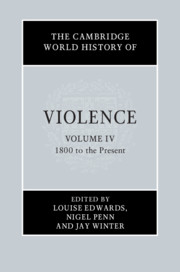Book contents
- The Cambridge World History of Violence
- The Cambridge History of Violence
- The Cambridge World History of Violence
- Copyright page
- Contents
- Figures and Maps
- Contributors to Volume IV
- Introduction to Volume IV
- Part I Race, Religion and Nationalism
- Part II Intimate and Gendered Violence
- Part III Warfare, Colonialism and Empire in the Modern World
- Part IV The State, Revolution and Social Change
- 17 Change and Continuity in Collective Violence in France, 1780–1880
- 18 Geographies of Genocide: The European Rimlands, 1912–1948
- 19 Concentration Camps
- 20 Violence in Revolutionary China, 1949–1963
- 21 Anti-Communist Violence in Indonesia, 1965–1966
- 22 The Violence of the Cold War
- 23 Quotidian Violence in the French Empire, 1890–1940
- 24 Violence, the State and Revolution in Latin America
- 25 Structural Violence during the Cambodian Genocide, 1975–1979
- 26 The Origins of Modern Terrorism
- Part V Representations and Constructions of Violence
- Index
- References
24 - Violence, the State and Revolution in Latin America
from Part IV - The State, Revolution and Social Change
Published online by Cambridge University Press: 13 March 2020
- The Cambridge World History of Violence
- The Cambridge History of Violence
- The Cambridge World History of Violence
- Copyright page
- Contents
- Figures and Maps
- Contributors to Volume IV
- Introduction to Volume IV
- Part I Race, Religion and Nationalism
- Part II Intimate and Gendered Violence
- Part III Warfare, Colonialism and Empire in the Modern World
- Part IV The State, Revolution and Social Change
- 17 Change and Continuity in Collective Violence in France, 1780–1880
- 18 Geographies of Genocide: The European Rimlands, 1912–1948
- 19 Concentration Camps
- 20 Violence in Revolutionary China, 1949–1963
- 21 Anti-Communist Violence in Indonesia, 1965–1966
- 22 The Violence of the Cold War
- 23 Quotidian Violence in the French Empire, 1890–1940
- 24 Violence, the State and Revolution in Latin America
- 25 Structural Violence during the Cambodian Genocide, 1975–1979
- 26 The Origins of Modern Terrorism
- Part V Representations and Constructions of Violence
- Index
- References
Summary
Exceptionally high levels of state-centered or “public” violence have been a distinguishing feature of the nineteen Latin American republics ever since the separation of nearly all of them, two centuries ago, from the monarchies of Spain and Portugal. Largely unbidden by those upon whom it was conferred, independence proceeded from 1808 to 1824 in ways that strongly conditioned the secular crisis of order that followed. Four phases of state making can be correlated with shifts in the nature and intensity of the violence that accompanied each of them. By the early twenty-first century, expansive state institutions nominally subject to the authority of liberal-democratic ideas appeared to be firmly entrenched in most of the region. If an organized and strictly political kind of violence had largely faded, other kinds of violence, newly contoured, surged to historic highs, within and around state institutions that for the most part flaunted their customary tolerance for varying levels of nonfeasance, incompetence and venality. The underlying, historically patterned failure was not that of the state per se. Rather, it was the shallowness of allegiance, across society, to the authority (in the contemporary case, that of liberal democracy) to which the state appealed as the source of its legitimacy.
- Type
- Chapter
- Information
- The Cambridge World History of Violence , pp. 490 - 509Publisher: Cambridge University PressPrint publication year: 2020

